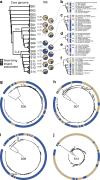The antimicrobial potential of Streptomyces from insect microbiomes
- PMID: 30705269
- PMCID: PMC6355912
- DOI: 10.1038/s41467-019-08438-0
The antimicrobial potential of Streptomyces from insect microbiomes
Abstract
Antimicrobial resistance is a global health crisis and few novel antimicrobials have been discovered in recent decades. Natural products, particularly from Streptomyces, are the source of most antimicrobials, yet discovery campaigns focusing on Streptomyces from the soil largely rediscover known compounds. Investigation of understudied and symbiotic sources has seen some success, yet no studies have systematically explored microbiomes for antimicrobials. Here we assess the distinct evolutionary lineages of Streptomyces from insect microbiomes as a source of new antimicrobials through large-scale isolations, bioactivity assays, genomics, metabolomics, and in vivo infection models. Insect-associated Streptomyces inhibit antimicrobial-resistant pathogens more than soil Streptomyces. Genomics and metabolomics reveal their diverse biosynthetic capabilities. Further, we describe cyphomycin, a new molecule active against multidrug resistant fungal pathogens. The evolutionary trajectories of Streptomyces from the insect microbiome influence their biosynthetic potential and ability to inhibit resistant pathogens, supporting the promise of this source in augmenting future antimicrobial discovery.
Conflict of interest statement
The authors declare no competing interests.
Figures





Similar articles
-
Microbial symbionts of insects as a source of new antimicrobials: a review.Crit Rev Microbiol. 2021 Sep;47(5):562-579. doi: 10.1080/1040841X.2021.1907302. Epub 2021 May 25. Crit Rev Microbiol. 2021. PMID: 34032192 Review.
-
Marine sediment-derived Streptomyces bacteria from British Columbia, Canada are a promising microbiota resource for the discovery of antimicrobial natural products.PLoS One. 2013 Oct 10;8(10):e77078. doi: 10.1371/journal.pone.0077078. eCollection 2013. PLoS One. 2013. PMID: 24130838 Free PMC article.
-
Antimicrobial discovery from natural and unusual sources.J Pharm Pharmacol. 2018 Oct;70(10):1287-1300. doi: 10.1111/jphp.12976. Epub 2018 Jul 12. J Pharm Pharmacol. 2018. PMID: 30003546 Review.
-
Integrative Genomics and Bioactivity-Guided Isolation of Novel Antimicrobial Compounds from Streptomyces sp. KN37 in Agricultural Applications.Molecules. 2024 Apr 28;29(9):2040. doi: 10.3390/molecules29092040. Molecules. 2024. PMID: 38731531 Free PMC article.
-
Unleashing the Potential of Microbial Natural Products in Drug Discovery: Focusing on Streptomyces as Antimicrobials Goldmine.Curr Top Med Chem. 2021;21(26):2374-2396. doi: 10.2174/1568026621666210916170110. Curr Top Med Chem. 2021. PMID: 34530711 Review.
Cited by
-
Gut Bacteria of Rattus rattus (Rat) Produce Broad-Spectrum Antibacterial Lipopeptides.ACS Omega. 2021 Apr 26;6(18):12261-12273. doi: 10.1021/acsomega.1c01137. eCollection 2021 May 11. ACS Omega. 2021. PMID: 34056379 Free PMC article.
-
A complete and flexible workflow for metaproteomics data analysis based on MetaProteomeAnalyzer and Prophane.Nat Protoc. 2020 Oct;15(10):3212-3239. doi: 10.1038/s41596-020-0368-7. Epub 2020 Aug 28. Nat Protoc. 2020. PMID: 32859984
-
Microbial community profiling and culturing reveal functional groups of bacteria associated with Thai commercial stingless worker bees (Tetragonula pagdeni).PLoS One. 2023 Mar 1;18(3):e0280075. doi: 10.1371/journal.pone.0280075. eCollection 2023. PLoS One. 2023. PMID: 36857385 Free PMC article.
-
Actinobacteria Community and Their Antibacterial and Cytotoxic Activity on the Weizhou and Xieyang Volcanic Islands in the Beibu Gulf of China.Front Microbiol. 2022 Jul 12;13:911408. doi: 10.3389/fmicb.2022.911408. eCollection 2022. Front Microbiol. 2022. PMID: 35903476 Free PMC article.
-
Antimicrobial compounds were isolated from the secondary metabolites of Gordonia, a resident of intestinal tract of Periplaneta americana.AMB Express. 2021 Jul 30;11(1):111. doi: 10.1186/s13568-021-01272-y. AMB Express. 2021. PMID: 34331149 Free PMC article.
References
-
- Brown ED, Wright GD. Antibacterial drug discovery in the resistance era. Nature. 2016;529:336–343. - PubMed
Publication types
MeSH terms
Substances
Grants and funding
LinkOut - more resources
Full Text Sources

